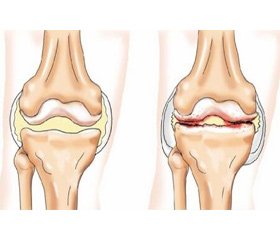Международный эндокринологический журнал 3 (67) 2015
Вернуться к номеру
The influence of metabolic disorders on clinical manifestations of osteoarthritis and the method for predicting of its course
Авторы: Oliinyk M.O., Zhuravlyova L.V. - Kharkiv National Medical University; Nessonova M.M. - National Pharmaceutical University, Kharkiv, Ukraine
Рубрики: Эндокринология
Разделы: Клинические исследования
Версия для печати
Introduction
Osteoarthritis (OA) is a major public health problem in the elderly. It affects activities of daily living and quality of life, leading to increased morbidity and mortality.
Metabolic syndrome (MS) is generally considered a combination of being overweight and having abdominal obesity and hypertension, dyslipidaemia, and impaired glucose tolerance or type 2 diabetes mellitus. OA and MS share age and obesity as risk factors. Numerous investigators have associated OA with various MS components.
A few population-based studies have demonstrated a dose–response relationship between risk factor accumulation for MS and OA; we have previously reported that OA presence was significantly associated with increase in the number of MS components.
The purpose of the present study was to determine the parameters of MS and its influence on the clinical signs of osteoarthritis and to develop the method of prediction of OA severity based on components of the MS.
Materials and methods
A total of 84 patients with OA (20 men, mean age 57,03 ± 0,70 years) were examined. The following parameters were determined in examined patients: waist circumference (WCR), body weight, height with subsequent calculation of body mass index (BMI) using the formula: BMI (kg/m2) = weight (kg) / height (m2). Systolic and diastolic blood pressure (BP) was measured. For the purpose of our research all patients were tested for serum glucose by glucose-oxidase Somogyi-Nelsone assay by standard method; the level of glycosylated hemoglobin (HbA1c) – kinetic method; the level of immunoreactive insulin (IRI) – ELISA method; indicators of lipid metabolism by standard method. Evaluation of IR was conducted using homeostasis model assesment (HOMA) using the formula: HOMA-IR = IRI, mcU/ml * serum glucose, mmol/L / 22,5. For all patients the X-Ray examinations of joints were made.
Correlation analysis was performed among all studied parameters according to their distribution law using Statistica 6.0 licensed program.
Results.
When analyzing the impact of metabolic syndrome indicators on WOMAC index, a significant effect of these parameters on the clinical course of OA was found due to the significant correlation between the WOMAC index and the following parameters: WCR (r=0,48; p <0.05), SBP (r=0.56, p <0.05) low-density lipoprotein cholesterol (LDL-c) (r=0,35; p <0.05), triglycerides (TG)(r=0,24; p <0,05), HbA1C (r=0,54 ; p <0.05), duration of OA (r=0,24; p <0.05).
The regression tree model was constructed to predict the total score by WOMAC scale depending on MS characteristics: WC; HbA1C, LDL-c, TG, BP values. Additionally, indicators of patients’ age and duration of OA were used as predictors of OA severity. The regression tree model splits the set of patients into disjoint subsets, characterized by a range of values, which in turn, explain the variables, and provides corresponding values of WOMAC scale total score for each such subset of patients.
This method provides possibility to predict the severity of pain and lack of joint function with probability 86.1%, i.e., to determine the number of points that patient might receive by WOMAC scale, without questioning, and using only the mentioned above indicators of metabolic syndrome.
Conclusions
1. The relationship between WOMAC index and indicators of MS, such as abdominal obesity, HbA1C, BP, LDL and TG was determined.
2. Abdominal obesity and carbohydrate metabolism may have greatest impact on the severity of pain, limitation of joint function, decrease of physical activity and limitation of mobility in patients with OA and MS.
3. In this study, regression tree model was constructed to predict the total score by WOMAC scale depending on MS characteristics.

